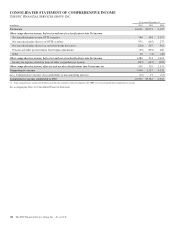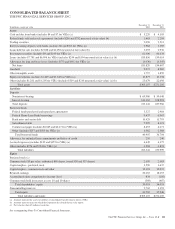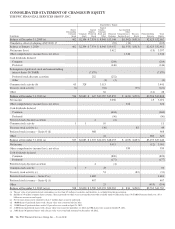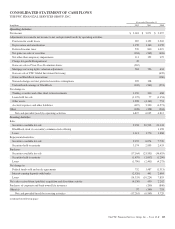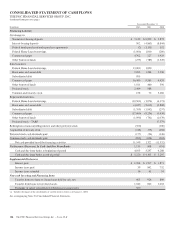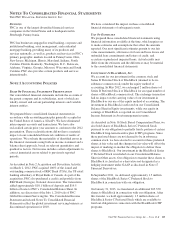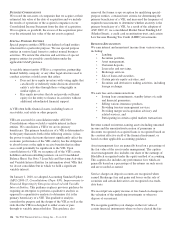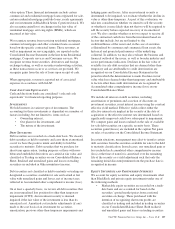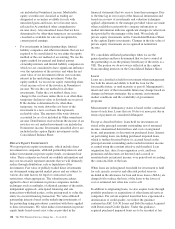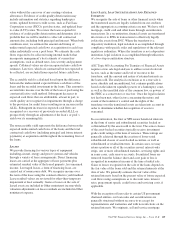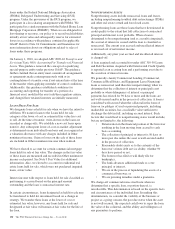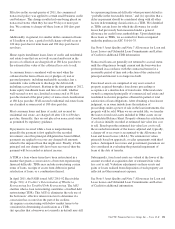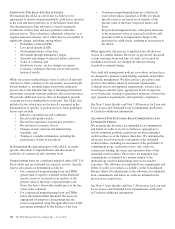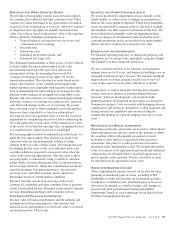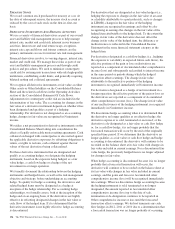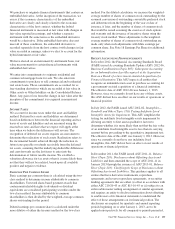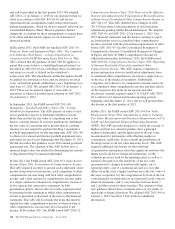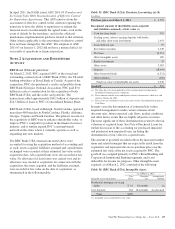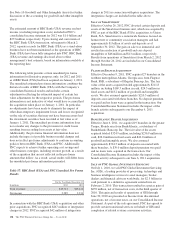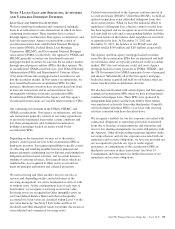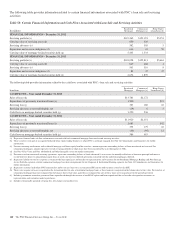PNC Bank 2012 Annual Report Download - page 149
Download and view the complete annual report
Please find page 149 of the 2012 PNC Bank annual report below. You can navigate through the pages in the report by either clicking on the pages listed below, or by using the keyword search tool below to find specific information within the annual report.loans under the Federal National Mortgage Association
(FNMA) Delegated Underwriting and Servicing (DUS)
program. Under the provisions of the DUS program, we
participate in a loss-sharing arrangement with FNMA. We
participated in a similar program with the Federal Home Loan
Mortgage Corporation (FHLMC). When we are obligated for
loss-sharing or recourse, our policy is to record such liabilities
initially at fair value and subsequently reserve for estimated
losses in accordance with guidance contained in applicable
GAAP. Refer to Note 24 Commitments and Guarantees for
more information about our obligations related to sales of
loans under these programs.
On January 1, 2010, we adopted ASU 2009-16 Transfers and
Servicing (Topic 860): Accounting For Transfers of Financial
Assets. This guidance removed the concept of a qualifying
special-purpose entity under previous GAAP. The guidance
further clarified that an entity must consider all arrangements
or agreements made contemporaneously with or in
contemplation of a transfer even if not entered into at the time
of the transfer when applying surrender of control conditions.
Additionally, this guidance established conditions for
accounting and reporting for transfer of a portion of a
financial asset, modified the asset sale/derecognition criteria,
and changed how retained interests are initially measured.
L
OANS
H
ELD
F
OR
S
ALE
We designate loans as held for sale when we have the intent to
sell them. We transfer loans to the Loans held for sale
category at the lower of cost or estimated fair value less cost
to sell. At the time of transfer, write-downs on the loans are
recorded as charge-offs. We establish a new cost basis upon
transfer. Any subsequent lower-of-cost-or-market adjustment
is determined on an individual loan basis and is recognized as
a valuation allowance with any charges included in Other
noninterest income. Gains or losses on the sale of these loans
are included in Other noninterest income when realized.
We have elected to account for certain commercial mortgage
loans held for sale at fair value. The changes in the fair value
of these loans are measured and recorded in Other noninterest
income each period. See Note 9 Fair Value for additional
information. Also, we elected to account for residential real
estate loans held for sale, which were not purchased impaired
loans, at fair value.
Interest income with respect to loans held for sale classified as
performing is accrued based on the principal amount
outstanding and the loan’s contractual interest rate.
In certain circumstances, loans designated as held for sale may
be transferred to held for investment based on a change in
strategy. We transfer these loans at the lower of cost or
estimated fair value; however, any loans held for sale and
designated at fair value will remain at fair value for the life of
the loan.
N
ONPERFORMING
A
SSETS
Nonperforming assets include nonaccrual loans and leases,
including nonperforming troubled debt restructurings (TDRs)
and other real estate owned and foreclosed assets.
Nonperforming loans are those loans that have deteriorated in
credit quality to the extent that full collection of contractual
principal and interest is not probable. When a loan is
determined to be nonperforming (and as a result is impaired),
the accrual of interest is ceased and the loan is classified as
nonaccrual. The current year accrued and uncollected interest
is reversed out of net interest income.
Additionally, any prior year accrued and uncollected interest
is charged-off.
A loan acquired and accounted for under ASC 310-30 Loans
and Debt Securities Acquired with Deteriorated Credit Quality
is reported as an accruing loan and a performing asset due to
the accretion of interest income.
We generally classify Commercial Lending (Commercial,
Commercial Real Estate, and Equipment Lease Financing)
loans as nonaccrual (and therefore nonperforming) when we
determine that the collection of interest or principal is not
probable or when delinquency of interest or principal
payments has existed for 90 days or more and the loans are
not well-secured and/or in the process of collection. A loan is
considered well-secured when the collateral in the form of
liens on (or pledges of) real or personal property, including
marketable securities, has a realizable value sufficient to
discharge the debt in full, including accrued interest. Such
factors that would lead to nonperforming status would include,
but are not limited to, the following:
• Deterioration in the financial position of the borrower
resulting in the loan moving from accrual to cash
basis accounting,
• The collection of principal or interest is 90 days or
more past due unless the asset is well-secured and/or
in the process of collection,
• Reasonable doubt exists as to the certainty of the
borrower’s future debt service ability, whether 90
days have passed or not,
• The borrower has filed or will likely file for
bankruptcy,
• The bank advances additional funds to cover
principal or interest,
• We are in the process of liquidating the assets of a
commercial borrower, or
• We are pursuing remedies under a guarantee.
We charge-off commercial nonaccrual loans when we
determine that a specific loan, or portion thereof, is
uncollectible. This determination is based on the specific facts
and circumstances of the individual loan. In making this
determination, we consider the viability of the business or
project as a going concern, the past due status when the asset
is not well-secured, the expected cash flows to repay the loan,
the value of the collateral, and the ability and willingness of
any guarantors to perform.
130 The PNC Financial Services Group, Inc. – Form 10-K


